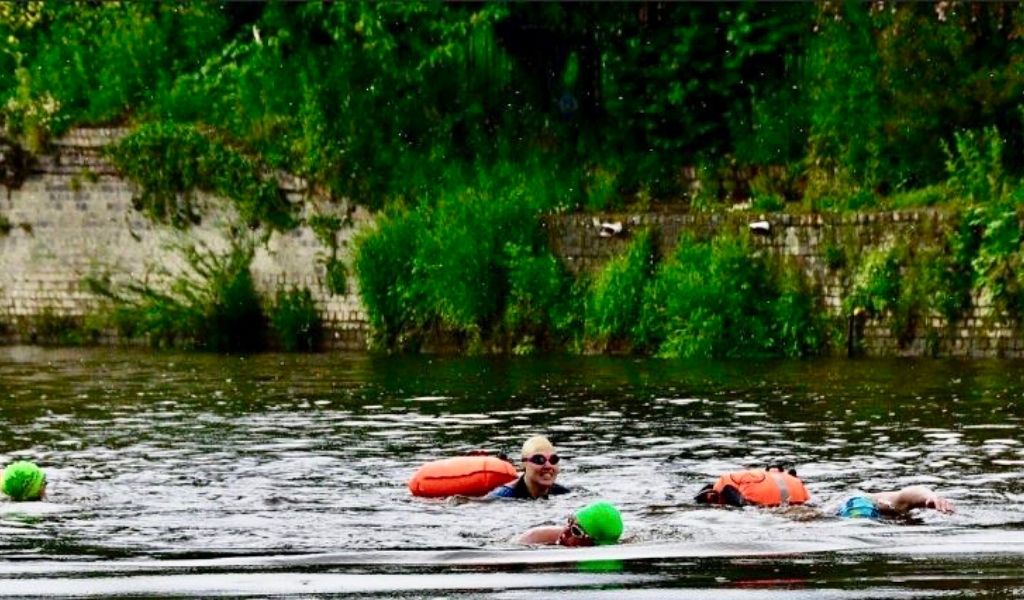Going with the flow by #TeamSelkie Matthew Davenport
Posted on Thursday, July 11 2019 09:30:00 PM in News by Karen Lee
Almost every outdoor patch of water has some form of flow, whether it is driven by the moon, the wind, the tide or the laws of gravity. Someone has even written a book about it ‘How to read water’ by Tristan Gooley, which ironically is quite a dry read. The most obvious places to see or feel the flow of water is in rivers, streams, waterfalls and of course the sea. With careful observation flow can even be seen in a puddle.
I started the month of June off with one of my most adventurous river swims to date where knowledge and understanding of the water flow was really important. The ‘Cross-Mersey’ swim carried with it a lot of risks and entry was not ‘open’, instead it was by application so that the organisers could be sure that everyone who got in the water knew what they were doing. Even so, on the day there was an extensive safety briefing and support boats were there to pull people out of the water if they needed it, and also to guide them out of the water if they missed the exit point. Despite having previously used the famous Mersey Ferry for my daily commute when I worked in Liverpool, I had never been so close or so frightened of the current as when the swimmers were taken by motor dinghy to the starting point. Having spoken with previous participants and researched the tidal flows I managed to get across safely and quickly, the final stage which required a brief swim across the current rather than with it was something that caught a handful of swimmers out.

Someone who has a much more experience of river swimming than me and going with the flow is my friend Melissa Compton. She is attempting a record breaking swim of the length of the River Severn, as the first person to do so without a wetsuit and the first woman to complete it. The flow of the river has been far more unpredictable as there have been record amounts of rainfall during her attempt causing flooding and delays to her efforts. Whilst she was passing through Shrewsbury I had the privilege of a brief swim with her on her journey and was really impressed by her steely determination, particularly as she’d already had two bouts of hypothermia in the past five days. However when the rain subsided the current was still really fast and she caught up on some of the distance lost to the rain.
River swimming is fantastically diverse and brings you up close and personal with natural and human impacts on the countryside. The Thames Marathon, a 14 km swim held in August is a brilliant example of this as the course follows the flow through areas engineered by humans and also through the path that nature has chosen. As the event is downstream the current helps and last year despite the heatwave that reduced water levels, I managed a steady 3 km pace which was aided both by the current and the Selkie ‘Spirit’ wetsuit I was wearing. I don’t normally wear a wetsuit so was very impressed that I finished the event with no chaffing and a decent finish time.

I recently recorded an interview with the ‘Swim Wild Podcast’ and swam in the River Dee above Llangollen in Wales. That far inland sometimes there is run-off from farmer’s fields that affects water quality, and further downstream near Chester, Victorian water treatment facilities are often overwhelmed, meaning that untreated sewage enters the river directly. Welsh Water are aware of this, as are local environmental campaigners, and despite positive early conversations, promises to tackle this by the water company have been slow to progress.


I would encourage you to enjoy the outdoors safely this summer and at the very least to consider wearing a tow-float, bright swim-cap, goggles and ear plugs when you get in the water.
The Royal Life Saving Society (RLSS) launched the Drowning Prevention Week #DPW in the UK on 14 June 2019 and there is a real commitment to make sure that if a drowning can be prevented, it is. There are really simple steps that everyone can take to help reduce the chances of drowning such as swimming in supervised areas, being aware of the current, swimming with friends and using safety equipment.
On the same day that the Drowning Prevention Week started, a tragic event unfolded in America. Charles Van Der Horst was an inspirational swimmer, a doctor, a civil rights campaigner, a husband, a father, a great many things to many people. He was taking part in the 8 Bridges Hudson River Swim. The event was well organised, had safety boats and shore watch for each swimmer, emergency service cover and thorough contingency planning. He drowned in the 7th stage of the 120-mile swim. He was skilled, experienced and had endurance. His shore watch saw him disappear from sight, probably following a cardiac event, and immediately raised the alarm. He had gone with the flow from this life to the next, doing something that he loved. Not everything can be prevented but we owe it to people around us to do everything we can to be as safe as possible in the water.


